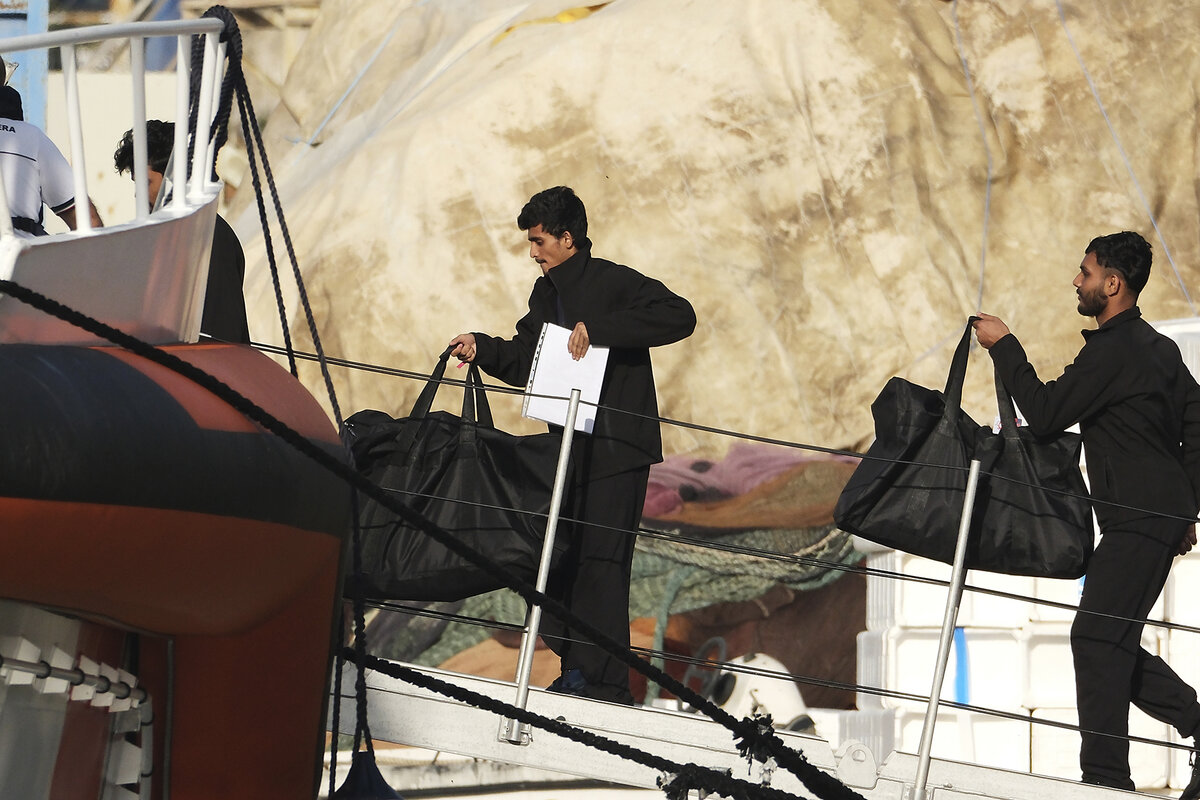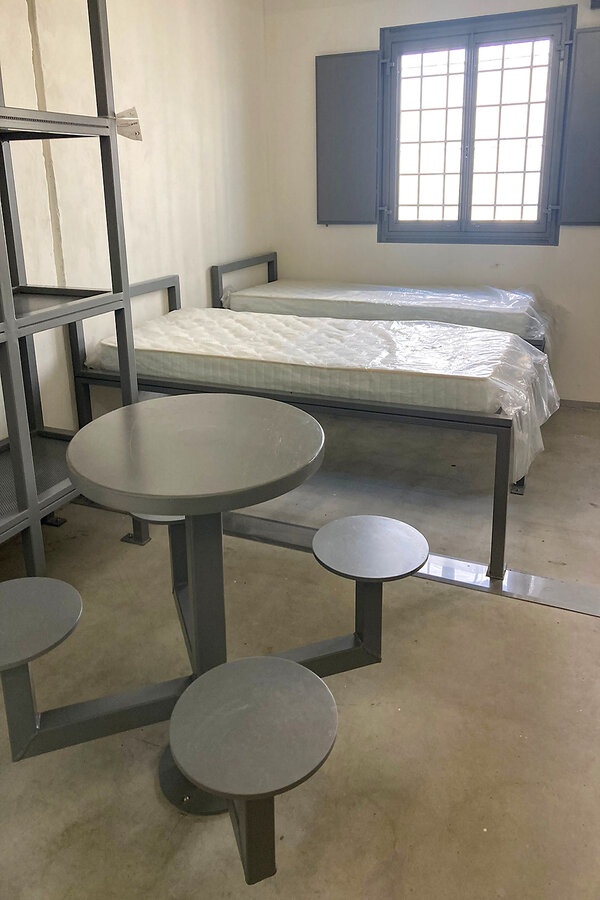Europe is trying to cut back migration. Can it find a legal way to do it?
Loading...
| Shëngjin, Albania; and Basel, Switzerland
Surprised by an unexpected court ruling, Italian Prime Minister Giorgia Meloni is fighting for the survival of her newly inaugurated migrant-processing centers in Albania. Widely hailed as a model by European politicians pushing a tougher line on migration, the project has endured an inauspicious launch.
The first batch of 16 migrants, young men from Egypt and Bangladesh, arrived last Wednesday. Within hours, it was decided that four of them should be brought to Italy on the grounds that they were either minors or “vulnerable,” physically or mentally.
Then, on Friday, the special immigration unit of a court in Rome threw a major wrench in the works of the five-year €670 million ($724 million) plan to process Italian asylum applications offshore. It ruled that the remaining 12 migrants cannot be sent back to Bangladesh or Egypt because they are not safe countries.
Why We Wrote This
European countries such as Italy are trying to reduce immigration by moving asylum-seekers’ processing offshore – in Italy’s case, to Albania. But while the approach is increasingly popular, its legality remains suspect.
The Italian government is furious. “Politicized judges have decided that there are no safe countries of origin: it is impossible to detain those who enter illegally, it is forbidden to repatriate illegal immigrants,” Ms. Meloni’s hard-right party, Brothers of Italy, posted on the social platform X. “They want to abolish Italy’s borders. We will not let them.”
Italy’s deal to process asylum applications in Albania has sparked considerable interest among European policymakers. Since the crisis of 2015-16, migration has become a hot-button issue across the European Union, reshaping domestic politics and fueling division. In Italy, it empowered a strong right-wing government that now sets the bloc’s tone on migration.
“If skeptical views regarding migration and more open borders continue to gain ground among European voters ... this tension between judicial decisions and popular demands could pose a significant challenge for liberal democracies,” says political analyst Teresa Nogueira Pinto, who teaches at the Universidade Lusófona in Lisbon, Portugal.
“Out of the box” or out of order?
The Rome court’s ruling followed an Oct. 4 decision by the European Court of Justice, which tightened the definition of what counts as a safe country to which failed asylum-seekers can legally be returned. Countries such as Tunisia, Egypt, and Bangladesh can only be declared safe if the entire territory is free of danger and nobody faces the threat of persecution.
Italy last year bore the brunt of irregular immigration into Europe, and Ms. Meloni had come to power on promises to stop smugglers from bringing people into the bloc. The deal with Albania, which aspires to join the EU, was recently endorsed by European Commission President Ursula von der Leyen as an example of “out-of-box thinking.”
The two centers in Albania are sleekly designed but prisonlike. They were built to process single male migrants intercepted while trying to cross the Mediterranean from North Africa. Children and families are still to be brought to Italy. Asylum applications, dealt with remotely from Italy, are supposed to be processed in 28 days.
The goal is to handle up to 36,000 migrants and refugees a year. The assumption was that the overwhelming majority would be judged to be economic migrants rather than genuine refugees and therefore repatriated to their countries of origin.
This was never going to be simple. Countries of origin must cooperate with repatriations, which is not always the case. And even when they do, the Court of Justice ruling earlier this month limits the range of countries to which the EU can legally repatriate failed asylum applicants.
Many observers also question how it will be possible to assess migrants in less than a month in Albania when it can take years to do the same job in Italy.
Matteo Villa, a senior researcher with the Institute for International Political Studies think tank in Rome, says he expected the plan to founder. “But I’m surprised that it went so bad, so fast,” he says. “It was always destined to be a disaster. It is mind-boggling that it went ahead in the first place.”
The government has limited options in trying to keep the offshore plan alive, says Mr. Villa. “They can legally try to circumvent [the ruling], but it’s going to be very hard.”
Out of sight, out of mind
Nonetheless, some analysts say the concepts underpinning the Albania-Italy deal will likely remain in play. The Italian project echoes the United Kingdom’s plans to send asylum-seekers to Rwanda. The British Parliament approved the idea, but execution stalled due to legal challenges. New British Prime Minister Keir Starmer scrapped the plan in July.
Replicas of the Albania deal appear likely despite the legal and political challenges they would face. Many governments like the “out of sight, out of mind” approach.
“Many member states want to pursue a similar model,” says Hanne Beirens, director of the Brussels-based nongovernmental organization Migration Policy Institute Europe. “The question is not whether the political interest will be maintained, but whether it will be feasible to implement.”
“At this moment, almost all EU leaders are modifying ... their stances on migration, adopting a more restrictive approach and even expressing doubts about multiculturalism,” notes Dr. Nogueira Pinto.
Last April, the EU adopted a new pact on migration and asylum, creating a Europe-wide system designed to speed up asylum procedures, among other goals. It leaves room for governments to offshore migrant processing and holds out the prospect that more failed asylum applicants will be returned to their home countries – an ambition close to Ms. von der Leyen’s heart.
Europeans are deeply influenced by the memory of 2 million people arriving in the EU in 2015-16. This triggered a “never again” mindset, Dr. Beirens suggests, and pressure rose for governments to impose stricter controls on economic migration.
That focus was sharpened, she adds, by the post-COVID-19 surge in migrant crossings. Austria, for example, is experiencing a wave of migrants not seen since 2015-16. That trend, combined with major EU elections, has pushed migration up the broader political agenda.
Across the continent, the mood is changing. Countries that once upheld the EU asylum system, such as Germany, now question their capacity to manage further influxes, especially after the arrival of Ukrainian refugees. Germany has reintroduced border controls, citing its overwhelmed asylum systems.
The Netherlands, traditionally a supporter of EU-wide migration policies, recently asked to be allowed to opt out of the EU migration pact. The coalition government dominated by far-right politician Geert Wilders is now floating the idea of sending rejected asylum-seekers to Uganda.
And as increasing numbers of Belarusians try to get into Poland, Warsaw wants to temporarily suspend the right to asylum.
“A series of proposals are being made that no longer seem to account for the rules and basic principles that have been laid down in EU migration frameworks for the last three decades,” says Dr. Beirens. “It is really quite a drastic change that we have seen in a very short period of time.”







